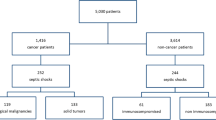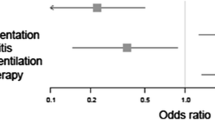Abstract
Goals of work
To study outcome and its predictive factors in cancer patients admitted to the ICU with septic shock, and the implications of neutropenia as a risk factor in this advanced stage of systemic inflammatory response.
Patients and methods
A prospective consecutive observational cohort study was conducted in 73 adults with cancer and septic shock admitted to the ICU at the Cancer Medical Center associated with the University of Buenos Aires.
Main results
The mortality rate from septic shock was 53.4% (95%CI 41.9 to 64.8%). The mean Acute Physiology and Chronic Health Evaluation (APACHE) II score on admission, the mean number of organ dysfunctions on admission or during the ICU stay, liver dysfunction, respiratory dysfunction, and the need for mechanical ventilation were predictive of mortality in a univariate analysis. Neutropenia was not associated with a worse prognosis in terms of mortality (56%) or mean days of ICU stay (6.64 days) in comparison with nonneutropenic patients (52.1% and 6.8 days) in the univariate analysis. In the logistic regression model only the need for mechanical ventilation and liver dysfunction remained independent predictors of mortality.
Conclusions
Septic shock among cancer patients admitted to the ICU has a mortality rate similar to that reported for mixed populations, and it is particularly increased when hepatic or respiratory dysfunction develop. Neutropenia on admission does not seem to modify outcome.
Similar content being viewed by others
References
Azoulay E, Moreau D, Alberti C, et al (2000) Predictors of short-term mortality in critically ill patients with solid malignancies. Intensive Care Med 26:1817–1823
Bellingan G (2000) Leukocytes: friend or foe. Intensive Care Med [Suppl] 26:s111–s118
Blot F, Guiguet M, Nitenberg G, et al (1997) Prognostic factors for neutropenic patients in an intensive care unit: respective roles of underlying malignancies and acute organ failures. Eur J Cancer 33:1031–1037
Blot F, Cordonier C, Nitenberg G, et al (2001) Severity of illness scores: are they useful in febrile neutropenic adult patients in hematology wards? Crit Care Med 29:2125–2131
Bogolioubov A, Keefe DL, Groeger JS (2001) Circulatory shock. Crit Care Clin 17:697–719
Boussat S, El’rini T, Dubiez A, et al (2000) Predictive factors of death in primary lung cancer patients on admission to the intensive care unit. Intensive Care Med 26:1811–1816
Boxer L, Dale DC (2003) Neutropenia: causes and consequences. Semin Hematol 39:75–81
Darmon M, Azoulay E, Alberti C, et al (2002) Impact of neutropenia duration on short-term mortality in neutropenic critically ill cancer patients. Intensive Care Med 28:1775–1780
Dhainaut JF, Marin N, Mignon A, et al (2000) Hepatic response to sepsis: interaction between coagulation and inflammatory processes. Crit Care Med [Suppl] 29:s42–s47
Groeger JS, Lemeyow S, Price K, Nierman DM, et al (1998) Multicenter outcome study of cancer patients admitted to the intensive care unit: a probability of mortality model. J Clin Oncol 16:761–770
Guiguet M, Blot F, Escudier B, Antoun S, Leclercq B, Nitenberg G (1998) Severity-of-illness scores for neutropenic cancer patients in an intensive care unit: which is the best predictor? Do multiple assessment times improve the predictive value? Crit Care Med 26:488–493
Haj MA, Neilly IJ, Robbie LA, et al (1995) Influence of white blood cells on the fibrinolytic response to sepsis: studies of septic patients with or without severe leucopenia. Br J Haematol 90:541–547
Kress JP, Christenson J, Pohlman AS, et al (1999) Outcomes of critically ill cancer patients in a university hospital setting. Am J Respir Crit Care Med 160:1957–1961
Kroschinsky FK, Weise M, Illmer T, et al (2002) Outcome and prognostic features of intensive care unit treatment in patients with hematologic malignancies. Intensive Care Med 28:1294–1300
Laufe MD, Simon RH, Flint A, et al (1986) Adult respiratory distress syndrome in neutropenic patients. Am J Med 80:1022–1026
Lloyd-Thomas AR, Wright I, Lister TA, et al (1988) Prognosis of patients receiving intensive care for life threatening medical complications of haematologic malignancy. BMJ 296:1025–1029
Luna CM, Videla A, Mattera J, et al (1999) Blood cultures have limited value in predicting severity of illness and as a diagnostic tool in ventilator-associated pneumonia. Chest 116:1075–1084
Marshall JC, Cook DJ, Christou NV, et al (1995) Multiple organ dysfunction score: a reliable descriptor of a complex clinical outcome. Crit Care Med 23:1638–1652
Massion PB, Dive AM, Doyen C, et al (2002) Prognosis of hematologic malignancies does not predict intensive care unit mortality. Crit Care Med 30:2260–2270
Muckart DJJ, Bhagwanjee S (1997) American College of Chest Physicians/Society of Critical Care Medicine Consensus Conference definitions of the systemic inflammatory response syndrome and allied disorders in relation to critically injured patients. Crit Care Med 25:1789–1795
Neilly IJ, Copland M, Haj M, et al (1995) Plasma nitrate concentrations in neutropenic and non-neutropenic patients with suspected septicaemia. Br J Haematol 89:199–202
Ognibene FP, Martin SE, Parkers MM, et al (1986) Adult respiratory distress syndrome in patients with severe neutropenia. N Engl J Med 315:547–551
Price KJ, Thall PF, Kish SK, et al (1998) Prognostic indicators for blood and marrow transplant patients admitted to an intensive care unit. Am J Respir Crit Care Med 158:876–884
Rangel-Frausto MS, Pittet D, Costigan M, et al (1995) The natural history of the systemic inflammatory response syndrome (SIRS). A prospective study. JAMA 273:117–123
Regazzoni CJ, Khoury M, Irrazabal C, et al (2003) Neutropenia and the development of the systemic inflammatory response syndrome. Intensive Care Med 29:135–138
Schuster DP, Marion JM (1983) Precedents for meaningful recovery during treatment in a medical intensive care unit. Am J Med 75:402–408
Sculier JP, Paesmans M, Markiewicz E, Berghmans T (2000) Scoring systems in cancer patients admitted for an acute complication in a medical intensive care unit. Crit Care Med 28:2786–2792
Staudinger T, Stoiser B, Müllner M, et al (2000) Outcome and prognostic factors in critically ill cancer patients admitted to the intensive care unit. Crit Care Med 28:1322–1328
Author information
Authors and Affiliations
Corresponding author
Rights and permissions
About this article
Cite this article
Regazzoni, C.J., Irrazabal, C., Luna, C.M. et al. Cancer patients with septic shock: mortality predictors and neutropenia. Support Care Cancer 12, 833–839 (2004). https://doi.org/10.1007/s00520-004-0667-5
Received:
Accepted:
Published:
Issue Date:
DOI: https://doi.org/10.1007/s00520-004-0667-5




